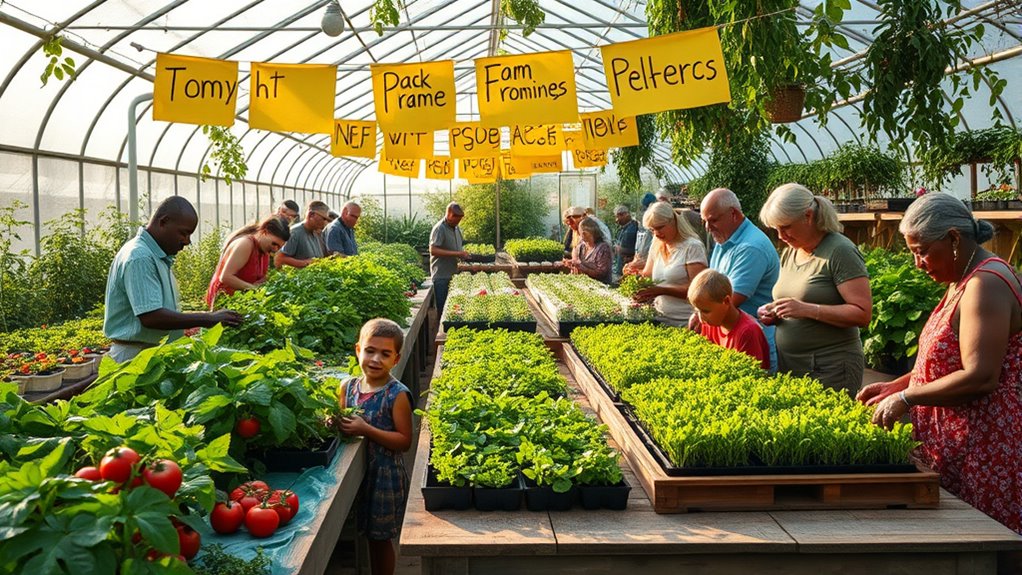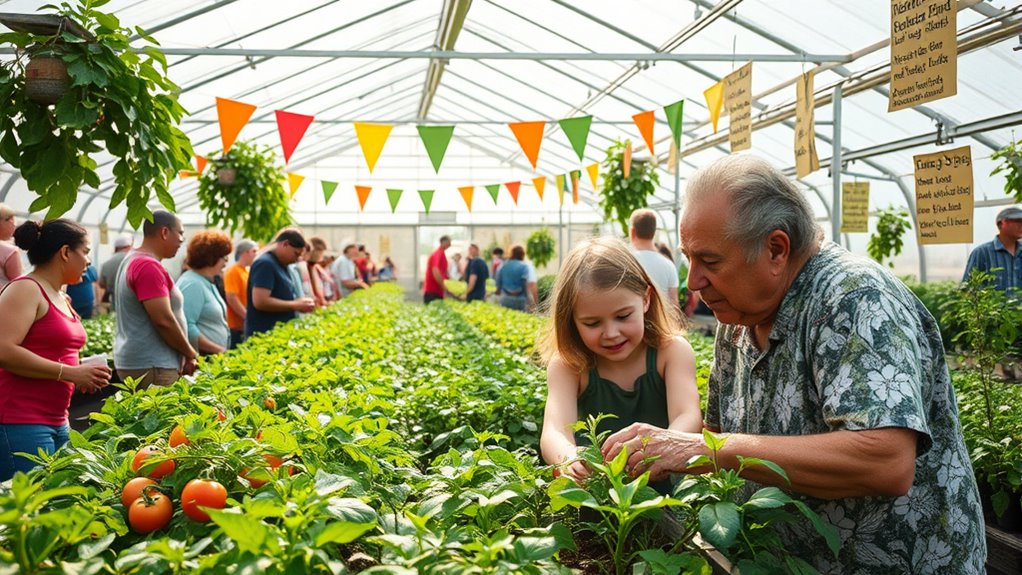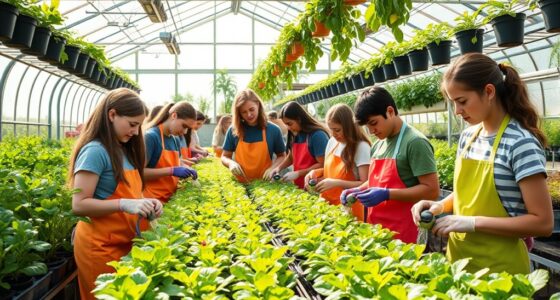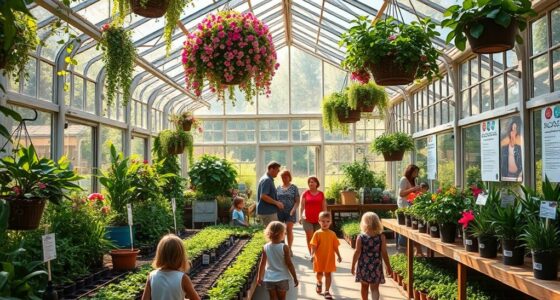Using storytelling and media for community greenhouses allows you to showcase successes, challenges, and personal stories that build emotional connections and inspire involvement. By sharing photos, videos, and social media updates, you can highlight environmental and social benefits, attract volunteers, and foster trust among stakeholders. Engaging content on platforms like Instagram or YouTube makes your efforts visible and relatable, encouraging others to support or replicate your initiatives. Keep going to discover more ways to make your community greenhouse thrive.
Key Takeaways
- Utilize digital storytelling through photos, videos, and social media to showcase greenhouse successes, challenges, and human stories.
- Engage communities by highlighting volunteers, beneficiaries, and local partnerships to foster emotional connections.
- Leverage platforms like Instagram, YouTube, and Facebook for broad outreach and sharing real-time updates.
- Use authentic visual content with accurate colors to create relatable, inspiring narratives that promote transparency.
- Demonstrate environmental and social impacts to attract stakeholders and reinforce greenhouses as vital urban infrastructure.

Community greenhouses are more than just places to grow plants—they’re hubs of connection and sustainability. When you think about urban agriculture, these green spaces become essential for transforming unused city spaces into productive environments. They provide fresh produce, promote eco-friendly practices, and foster a sense of community. But to truly amplify their impact, you need effective storytelling and media. Digital storytelling, in particular, offers a powerful way to share the successes, challenges, and human stories behind these green initiatives. You can create compelling narratives that resonate with diverse audiences, inspiring more people to get involved and support urban agriculture projects.
Community greenhouses foster connection, sustainability, and urban transformation through compelling digital storytelling.
By capturing stories through photos, videos, and social media, you personalize the greenhouse experience. Instead of just seeing a plot of plants, viewers learn about the individuals who tend these gardens, the volunteers who donate their time, and the families who benefit from fresh produce. This emotional connection encourages community engagement and attracts new volunteers or donors. Digital media also allows you to document progress over time—showcasing how a small patch of land transforms into a lush, productive space. These stories highlight not only the environmental benefits but also the social impact, such as improving food security and promoting environmental education.
Using digital storytelling tools, you can share urban agriculture initiatives beyond your local area, inspiring others in different cities to start their own green projects. Platforms like Instagram, YouTube, or Facebook enable you to reach a broad audience quickly and effectively. You can produce short videos that show planting days, harvest celebrations, or even setbacks and how the community overcomes them. These authentic stories foster transparency and build trust, making your greenhouse a symbol of resilience and hope.
Moreover, sharing your community greenhouse’s story can attract local businesses, schools, and nonprofits to collaborate. When you highlight the positive impact of urban agriculture through engaging media, you reinforce the value of community greenhouses as crucial urban infrastructure. It also creates a cycle of storytelling—where community members share their personal experiences, and those stories, in turn, inspire others to participate or advocate for more green spaces.
In essence, digital storytelling transforms the narrative of community greenhouses from simple gardening projects into vibrant stories of empowerment, sustainability, and community resilience. It makes your efforts visible, relatable, and inspiring. By leveraging media effectively, you turn your community greenhouse into a beacon of urban agriculture that not only nurtures plants but also nurtures connections among people. Incorporating color accuracy into visual content can further enhance storytelling by ensuring images and videos are vibrant and true to life, making the stories more compelling and trustworthy.
Frequently Asked Questions
How Can Storytelling Increase Community Engagement in Greenhouses?
You can boost community engagement by using narrative techniques that highlight personal stories and successes within the greenhouse. Emotional appeal makes these stories relatable and inspiring, encouraging others to participate. When you share how greenhouses impact individuals’ lives—like growing food or fostering connections—you create a sense of shared purpose. This active storytelling draws people in, making them feel connected and motivated to get involved in the greenhouse community.
What Media Platforms Are Most Effective for Promoting Community Greenhouses?
Like a beacon guiding ships, social media strategies shine brightly for promoting community greenhouses. You should focus on platforms like Facebook, Instagram, and Twitter to reach diverse audiences effectively. Local radio campaigns are also powerful, providing a personal touch that resonates within your community. Combining these media platforms maximizes outreach, boosts engagement, and encourages more people to connect with and support your greenhouses.
How Do Stories Influence Volunteer Participation in Greenhouse Projects?
Stories greatly influence volunteer participation by creating a narrative impact that resonates emotionally. When you share success stories or challenges faced, you motivate volunteers by showing the real impact of their work. This connection boosts volunteer motivation, making them feel part of something meaningful. Your stories inspire continued involvement and foster a sense of community, encouraging more people to join and stay committed to the greenhouse project.
What Are Best Practices for Visual Storytelling in Greenhouses?
You should focus on creating colorful narratives that captivate your audience and clearly convey your greenhouse’s mission. Use consistent visual elements like color schemes, fonts, and imagery to build a recognizable brand. Incorporate high-quality photos and videos that showcase your greenhouse’s activities and community impact. Keep your visuals authentic and engaging, making it easy for viewers to connect emotionally and stay interested in your story.
How Can Media Be Used to Educate About Sustainable Gardening?
Imagine urban farming blooming through your screen—media becomes a powerful tool to teach sustainable gardening. Use engaging digital campaigns to share tips, success stories, and tutorials that inspire action. Videos, infographics, and social media posts can demonstrate eco-friendly practices, making sustainable gardening accessible and exciting. You’ll empower communities, raise awareness, and foster a greener future—all through compelling media that educates and motivates.
Conclusion
By sharing stories and using media, you can truly connect people to community greenhouses. When you highlight real experiences and evoke emotions, you inspire others to care and get involved. Believe it’s possible to foster a sense of belonging and purpose through storytelling—after all, research shows that stories can change perceptions and motivate action. So, keep sharing those powerful stories; they’re the key to growing a stronger, more engaged community.









